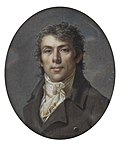File:François Dumont - Portrait of Mademoiselle Marie-Anne Adelaide Le Normand - 1921.911 - Cleveland Museum of Art.tif

Original file (5,311 × 6,574 pixels, file size: 99.91 MB, MIME type: image/tiff)
| This is a file from the Wikimedia Commons. Information from its description page there is shown below. Commons is a freely licensed media file repository. You can help. |
Summary
| François Dumont: Portrait of Mademoiselle Marie-Anne Adelaide Le Normand
|
|||||||||||||||||||||||||||
|---|---|---|---|---|---|---|---|---|---|---|---|---|---|---|---|---|---|---|---|---|---|---|---|---|---|---|---|
| Artist |
|
||||||||||||||||||||||||||
| Title | |||||||||||||||||||||||||||
| Object type |
painting / portrait miniature |
||||||||||||||||||||||||||
| Genre |
portrait miniature |
||||||||||||||||||||||||||
| Description |
|
||||||||||||||||||||||||||
| Date |
circa |
||||||||||||||||||||||||||
| Medium |
watercolor paint on ivory |
||||||||||||||||||||||||||
| Dimensions | Framed: 8.4 x 6.9 cm (3 5/16 x 2 11/16 in.); Unframed: 7.3 x 5.8 cm (2 7/8 x 2 5/16 in.) | ||||||||||||||||||||||||||
| Collection |
institution QS:P195,Q657415
|
||||||||||||||||||||||||||
| Current location |
European Painting and Sculpture |
||||||||||||||||||||||||||
| Accession number |
1921.911 (Cleveland Museum of Art) |
||||||||||||||||||||||||||
| Place of creation |
France |
||||||||||||||||||||||||||
| Credit line | Gift from J. H. Wade | ||||||||||||||||||||||||||
| References |
https://clevelandart.org/art/1921.911 |
||||||||||||||||||||||||||
| Source/Photographer | https://clevelandart.org/art/1921.911 | ||||||||||||||||||||||||||
Licensing
| This file is made available under the Creative Commons CC0 1.0 Universal Public Domain Dedication. | |
| The person who associated a work with this deed has dedicated the work to the public domain by waiving all of their rights to the work worldwide under copyright law, including all related and neighboring rights, to the extent allowed by law. You can copy, modify, distribute and perform the work, even for commercial purposes, all without asking permission.
http://creativecommons.org/publicdomain/zero/1.0/deed.enCC0Creative Commons Zero, Public Domain Dedicationfalsefalse |

|
This file was donated to Wikimedia Commons as part of a project with the Cleveland Museum of Art. See the Open Access at the Cleveland Museum of Art.
|
Captions
Items portrayed in this file
depicts
image/tiff
File history
Click on a date/time to view the file as it appeared at that time.
| Date/Time | Thumbnail | Dimensions | User | Comment | |
|---|---|---|---|---|---|
| current | 01:46, 6 April 2019 |  | 5,311 × 6,574 (99.91 MB) | Madreiling | pattypan 18.02 |
File usage
Global file usage
The following other wikis use this file:
- Usage on www.wikidata.org
Metadata
This file contains additional information, probably added from the digital camera or scanner used to create or digitize it.
If the file has been modified from its original state, some details may not fully reflect the modified file.
| Camera manufacturer | Sinar Photography AG |
|---|---|
| Camera model | Sinar CMV/ Sinarback eXact |
| Author | Howard Agriesti |
| Exposure time | 49/2,500 sec (0.0196) |
| ISO speed rating | 50 |
| Date and time of data generation | 2018:01:31 15:40:45: |
| Width | 5,311 px |
| Height | 6,574 px |
| Bits per component |
|
| Compression scheme | Uncompressed |
| Pixel composition | RGB |
| Image data location | 20,966 |
| Orientation | Normal |
| Number of components | 3 |
| Number of rows per strip | 6,574 |
| Bytes per compressed strip | 104,743,542 |
| Horizontal resolution | 300 dpi |
| Vertical resolution | 300 dpi |
| Data arrangement | chunky format |
| Software used | Adobe Photoshop CC (Windows) |
| File change date and time | 10:44, 8 February 2018 |
| Exposure Program | Not defined |
| Exif version | 2.21 |
| Shutter speed | 5.672 |
| Metering mode | Unknown |
| Light source | Unknown |
| Flash | Flash did not fire |
| Color space | sRGB |
| Exposure mode | Auto exposure |
| White balance | Auto white balance |
| warning | identify: Incompatible type for "RichTIFFIPTC"; tag ignored. `TIFFFetchNormalTag' @ warning/tiff.c/TIFFWarnings/912. identify: incorrect count for field "DateTimeOriginal" (21, expecting 20); tag trimmed. `/tmp/localcopy_f9960f541c7f.tif' @ warning/tiff.c/TIFFWarnings/912. identify: ASCII value for tag "DateTimeOriginal" does not end in null byte. `TIFFFetchNormalTag' @ warning/tiff.c/TIFFWarnings/912. identify: Incompatible type for "RichTIFFIPTC"; tag ignored. `TIFFFetchNormalTag' @ warning/tiff.c/TIFFWarnings/912. |



